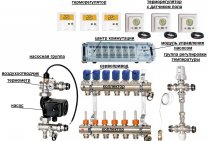What is better coil or direct flow
Coolers for moonshine stills, despite their similarity in principle of operation, have differences in characteristics. It is worth highlighting the advantages of each design separately.
The direct-flow refrigerator has a high efficiency. This reduces the consumption of water consumed for cooling. Adjusting the temperature in it is easier than in the coil, since the response is much faster. The main advantage of the once-through cooler is that the vapor passage tube is wide enough to avoid plugging. Because of them, there are pressure surges in the distillation cube, provoking a sharp boil of the mash and a violation of the process technology.
In addition to the once-through cooler, you can make a home-made cooling coil. The surface area of its inner tube is higher than that of the forward flow due to the helical design. Due to this, the cooling of the steam occurs faster. The dimensions of such a device are more compact, and it is easier to install.
It is impossible to say for sure which of the refrigerators is better. Each has its pros and cons. Moonshiners select the design according to their characteristics of the apparatus. The choice is influenced by the power, the volume of the drink and the tasks assigned to the device.
How to make a coil for a moonshine still
A coil for a moonshine still, as well as a straight-through, can be made with your own hands. Unlike the first design, its design is a little more difficult for home-made due to the fact that the copper tube will need to be bent into a spiral.
What to make a coil for moonshine? For its manufacture you will need:
- Copper annealed tube - 1.5 meters.
- Mandrel for winding a spiral - 1 piece.
- Fine sand
- Case (bucket or bottle) - 1 piece.
The first stage is the choice of the diameter of the tube and the length of the coil for the moonshine still. From a segment of 120 - 150 centimeters, a fairly compact and powerful refrigerator is obtained. The core diameter is taken to be about 10 millimeters. Another important parameter is the wall thickness of the tube. This criterion fluctuates around 0.8 - 1 millimeter. If you take a tube with a wall thickness less than specified, then there is a high chance of damaging it when bending. If you exceed the value, then it will be difficult to bend the spiral.
The selected tube must be tightly plugged at one end and filled with sand. It falls asleep very tightly, periodically tapping for even distribution. The other end of the filled tube is also sealed with a cork. Thanks to this, the tube does not flatten when winding on the mandrel. An alternative to sand as a filler can be soda. The main thing is to compact it as tightly as possible.
After that, you need to choose the basis for bending the spiral. The diameter of the mandrel must be greater than the diameter of the tube and depends on the intended size of the structure. For these purposes, a pipe 35 millimeters in diameter is suitable, which must be clamped in a vice. A copper tube is wound onto the prepared mandrel, through which alcohol vapor will flow. Between the turns it is necessary to leave a small step of 6 - 7 millimeters. To do this, you can wind the wire next to the tube. The beginning and end of the coil is best left long. The excess will then be cut off.
The curved tube is opened and freed from sand and installed in the housing. To do this, holes are made in the bottle in advance for the inlet and outlet of the coil, as well as for the circulation of water, if it is provided. If desired, you can make a body structure from a plastic pipe used in plumbing, and if you have skills, from metal.
To do this, you need to make 4 holes.2 of them, one at the top and bottom for the coil, which is located vertically in a cylindrical casing, and 2 in the side part for supplying and discharging water. The spiral structure is assembled, cooling pipes are inserted, and all connections are sealed and soldered. Such a cooler is installed on the distillation cube in the same way as the direct-flow one, using rubber tubes.
Often, stainless steel is used to make coils. It is quite durable and does not react. Aluminum and glass are less commonly used. The first material has a low service life, and the second is not suitable for home production. In any case, the choice is yours, and watching the video will help make it.
How to make a direct-flow refrigerator for moonshine
A direct-flow refrigerator for a moonshine still is quite simple to make with your own hands. At the same time, the cost of parts does not exceed a thousand rubles. The inner part of the shell-and-tube refrigerator is made of copper, and the outer part of the sewer pipe. The main components of the design:
- Copper and polypropylene tube of different diameters - 1 meter each.
- Tee - 2 pieces.
- Coupling with a plug - 2 pieces each.
- Fittings - 2 pieces.
- FUM tape for bonding strength.
The outer and inner tubes are selected in such a diameter that there is a gap of about 1.5 - 2 millimeters between them. It is in it that cold water will flow. From a polypropylene tube, it is necessary to cut off a piece about 60 centimeters long. It will become the outer casing of the entire structure. Tees are put on the ends. The best connection method is soldering. It is more simple and reliable, but requires a soldering iron. In its absence, heating can be applied. The tees are held for 3-4 minutes in boiling water and immediately put on the ends of the tube. With this method, there is a chance of getting burned, so you need to be extremely careful.
When the tees are installed, reducers are put on. The connection is carried out by soldering or by the method indicated above. In this case, only one edge of the structure will have to be lowered into the pan, and the other should be constantly held. After that, a hole of such a diameter is drilled in the plugs so that a copper tube passes through it.
It is important that it is located very tightly, without wide gaps. Plugs with holes are driven into the couplings, and fittings are inserted into the free holes of the tees
The threaded connection is sealed with FUM tape.
It remains to install the core. To do this, it is necessary to measure and saw off the copper tube so that it protrudes 2 to 3 centimeters from each edge of the casing. The resulting segment is inserted through the holes of the plugs. The last stage is the sealing of the connection between the tube and the body. To do this, you can use silicone sealant or universal glue. After the joint dries, the structure is considered finished. A rubber tube is used to connect the refrigerator to the distillation cube. The connection depends on the direction of water flow in the casing. Liquid and vapor must move towards each other.
It is possible to make a structure without using transitional couplings. In this case, it is necessary to take a copper and polypropylene tube of smaller diameters than in the previous version. Then the plugs are driven directly into the tees, and the connection of the copper tube with the casing is also carried out with a sealant.

